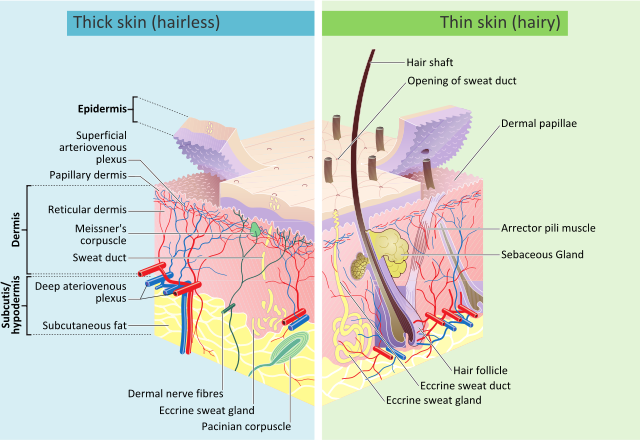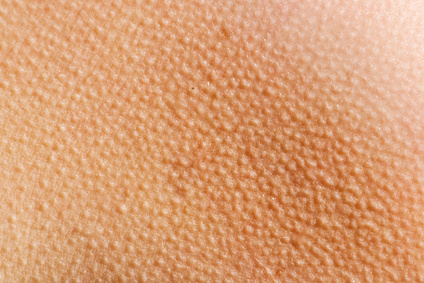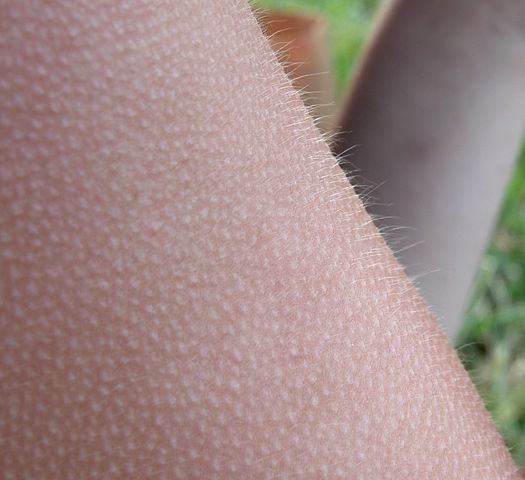Abnormal Goosebumps (Cutis Anserina) Causes
We all experience goosebumps when we are feeling cold or have a sudden fright but there are times when this otherwise normal reaction of the skin may in fact be abnormal. It can be considered as a symptom of some disease. Goosebumps have derived its name from the tiny bumps that form on the skin of a goose when its feathers are plucked. However, in humans abnormal goosebumps may not have anything to do with hair removal. It can occur with a number of neurological, hormone and infectious diseases as well as with the use of certain substances.
What is cutis anserina?
Cutis anserina is the medical term for the emergence of tiny bumps on the skin usually in response to the cold. We refer to these bumps as goosebumps. This phenomenon is also known as horripilation but this term is rarely used these days. It occurs when tiny muscles in the skin contract and lift up the hairs on the our skin, like on the arms and legs.
These tiny muscle are stimulated by nerves to contract and lift up the hair, or relax and let the hair lie flat. Even if a person does not have hair in these areas, the bumps will still form in response to nerve stimulation. The stimulation of goosebumps is not under voluntary control. This means that most of us cannot directly stimulate it to form unless we go into a cold area or see, hear or think of something frightening.

The involuntary part of the nervous system controls it and this is known as the autonomic system. Sometimes dysfunction of the autononomic system can cause abnormal goosebumps to arise along with other abnormally triggering other involuntary responses such as flushing or paleness of skin (due to blood flow), sweating and changes in heart rate. This is known as autonomic hyperreflexia or autonomic dysreflexia.
Causes of Abnormal Goosebumps
Each hair follicle has a muscle attached to it known as the arrector pili or erector pili muscle. It is a smooth muscle meaning that it is under involuntary control. Nerves from the sympathetic branch of the autonomic nervous system stimulate these muscles to contract. In humans, these hairs stand up to slow down the flow of air over the surface of the skin.
In this way it reduces heat loss from the surface in cold climates. However, it also stands up in response to emotions like fear, anger, pleasure, arousal and euphoria. Abnormal goosebumps are linked to two possible conditions – chills and abnormal hyperreflexia. However, it does not occur in every case of chills or abnormal hyperreflexia. Cutis anserina is also seen in corpses.

It is actually linked to rigor mortis where the muscles contract after death. Cutis anserina is an early sign of rigor mortis and considered to be a normal post-mortem finding. Sometimes goosebumps may arise with hair removal, particularly with waxing but it is a temporary reaction that resolves within minutes.
Causes of Chills
Chills occurs with fever and most of the time this is linked to infections. Fever is where there is an abnormal rise in body temperature. Chills is the involuntary shaking that may precede the onset of fever and/or occur with a fever. However, chills do not always occur with a fever.
- Common cold
- Cellulitis
- Influenza
- Infectious mononucleosis
- Gastroenteritis
- Malaria
- Meningitis
- Pneumonia
- Septicemia
- Tonsillitis
- Tuberculosis
- Urinary tract infections (UTIs)
Causes of Autonomic Hyperreflexia
The autonomic nervous system is stimulated by a range of factors in order to act on different parts of the body. When the ANS reacts abnormally or overreacts to stimulation then it may present with a host of signs and symptoms such as a raised heart rate, high blood pressure, excessive sweating, changes in skin color and abnormal goosebumps. It is important to understand that these physiologic changes are at times considered normal under certain conditions. Autonomic hyperreflexia may be caused by:
- Guillain-Barre syndrome
- Illicit substances (stimulants)
- Side effects of medication
- Spinal cord injury
- Traumatic brain injury
- Withdrawal from addictive substances
Certain hormonal disorders may causes symptoms similar to autonomic hyperreflexia – carcinoid syndrome, pheochromocytoma, serotonin syndrome and thyrotoxicosis.
When are goosebumps abnormal?
Although human skin varies in color, texture and appearance among individuals, goosebumps can occur in almost every person. It is not a cause for concern if it is short-lived and arises with known trigger factors like cold or emotions. In order to exclude these normal goosebumps from abnormal goosebumps, it is important to do simple things like turn up the heat, wear more clothes and try to stay relaxed.

Goosebumps will reverse within minutes if it is a normal physiologic response to cold or emotion. If goosebumps persist beyond these measures then it is possibly due to other pathologic factors. The other signs and symptoms that may be present include:
- Malaise (feeling of being unwell)
- Changes in appetite
- Raised or lowered body temperature
- Excessive sweating
- Very fast or slow heart rate
- High or low blood pressure
- Redness or paleness of the skin
- Pains (at a specific site) or general aches throughout the body
- Lightheadedness or dizziness
- Altered mental state
Does stress cause goosebumps?
Stress can cause goosebumps because it often triggers the same pathways as when we face danger. This is known as the fight or flight response. It is initiated when the brain identifies a danger, either present or impending, and readies the body for action – that is either to fend off the danger (fight response) or maximize the body’s resources to flee from the danger (flight response). However, these days the stress response is triggered even without any immediate danger in the vicinity.
Daily life can elicit a range of emotions from fear, to anxiety and anger. Coupled with worry about completing personal and work tasks as well as meeting financial obligations and the complexities that may arise with interpersonal relationships, the mind can experience intense stress despite there being no physical threat in the environment. This psychological stress acts in the same way as danger and the same nerve and hormone pathways are initiated as the fight or flight response. Goosebumps can therefore occur during these episodes of stress.
References
- Goosebumps. Medicine Net
- Autonomic Dysreflexia. NIH.gov





